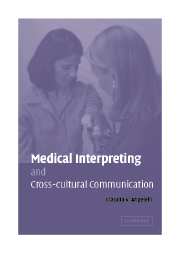Book contents
- Frontmatter
- Contents
- List of figures
- List of tables
- Acknowledgments
- List of abbreviations
- Prologue
- 1 Questioning invisibility
- 2 Communication in the medical encounter
- 3 A different set of lenses
- 4 California Hope: a public hospital in changing times
- 5 Putting it all together
- 6 Finding visibility
- 7 Interpreters' voices
- 8 Emerging metaphors and final words
- References
- Index
5 - Putting it all together
Published online by Cambridge University Press: 22 September 2009
- Frontmatter
- Contents
- List of figures
- List of tables
- Acknowledgments
- List of abbreviations
- Prologue
- 1 Questioning invisibility
- 2 Communication in the medical encounter
- 3 A different set of lenses
- 4 California Hope: a public hospital in changing times
- 5 Putting it all together
- 6 Finding visibility
- 7 Interpreters' voices
- 8 Emerging metaphors and final words
- References
- Index
Summary
During my stay at CH, I spent a lot of time with the informants, asking questions, observing, shadowing them, and taking notes on what they do and say. While doing this, I continuously followed “hunches – which we could call hypotheses – that helped [me] figure out why things happen as they do” (LeCompte and Schensul 1999:11). The recursive nature of questioning, obtaining answers, refining questions, getting more detailed answers, and searching for ways to corroborate, negate, clarify, or expand original formulations allowed me to reorganize my sense of what was happening at CH. In doing this, I paid close attention to negative evidence, i.e. behaviors, instances, or other facts that appeared to disconfirm the construct of a visible interpreter that I had already found. This was especially important, in order to avoid the temptation of dismissing these facts as anomalies. Instances when interpreters would step out of role and argue with providers on behalf of the patient were difficult to discern, and the process was time consuming. However, they were worth it, because they helped me refine and modify my search (Miles and Huberman 1984).
This recursive analysis started as soon as I entered CH and continued for three years. It was guided by copious inscriptions (head notes), descriptions (field notes that turned into conceptual memos for myself), and transcriptions. Throughout the course of my fieldwork, I tried to remain conscious of any biases about the field of interpreting that I might harbor.
- Type
- Chapter
- Information
- Medical Interpreting and Cross-cultural Communication , pp. 58 - 72Publisher: Cambridge University PressPrint publication year: 2004

